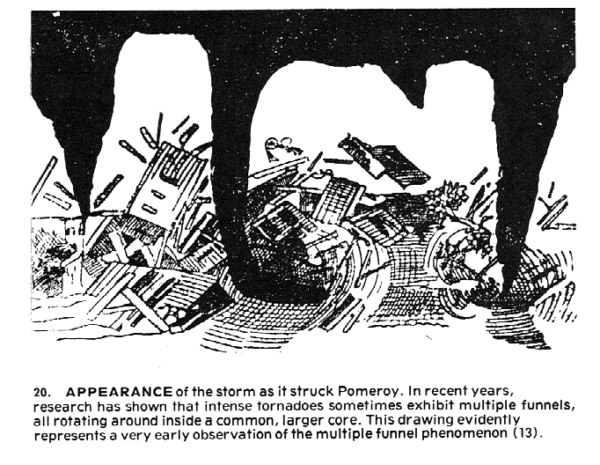Today In Weather History: The Pomeroy, Iowa Tornado Kills 71

Illustration of the Pomeroy Tornado from John L. Stanford’s 1977 book about Iowa tornadoes.
The town of Pomeroy, Iowa was a prosperous, thriving place in 1893. In the middle of the flat, Iowa prairie, the town of 1,000 spread across 30 blocks. On July 6, 1893, the air had a sultry, oppressive feel to it. Temperatures peaked around 90 degrees, with high humidity. According to the old timers, it was good cyclone weather. About 4 p.m., folks looked to the northwest and west as huge thunderheads poked into the sky. Those storms loomed higher and higher as they pushed southeastward.
Around 6:30 p.m., the western sky turned an inky black as the storms blotted out the sun. The clouds had an eerie greenish tint to them. Unbeknownst to the residents of Pomeroy, those clouds held a terror beyond their wildest fears. The storm was paralleling the Illinois Central Railroad line. Many scrambled for their cellars or cyclone caves as a tremendous roar could be heard. It was either an unscheduled freight train or something much worse.
At about 5 p.m., one of the storms had dropped a tornado around 5 p.m. in Cherokee County. It started moving east at first, then curved to the southeast, following the train tracks. The storm spit out several tornadoes that dropped and lifted. But as it turned southeastward, the parent storm intensified. A monstrous tornado dropped from the cumulonimbus near Storm Lake. It would stay on the ground for 56 miles. As it passed over the lake, it revealed the lake bottom momentarily before a six foot tidal wave sloshed back behind the twister.
The tornado missed several small towns, but Pomeroy would not be so lucky. At 6:45 p.m., the massive storm, sporting at least four multiple vortex funnels roared directly into the town. It had been on the ground for an hour and 45 minutes, but no one had thought to telegraph ahead of the slow moving (25 mph) tornado to give warning to other communities.
The F5 tornado produced a 400 yard path of total destruction right through the middle of town. Nothing was left standing. When the tornado had finished its five minute rampage, a silence fell across the devastation. Not a living thing moved. For many, they thought they were the only person to survive the disaster until cries for help and screams of pain began to emerge from the rubble.
Twenty blocks of the town were swept completely clean. Eighty percent of the residences were totally destroyed. The school and major churches were demolished. A total of 49 people were killed in Pomeroy. Only twenty one families escaped without injuries or fatalities. The cyclone caves saved dozens. Because of a high water table, the caves were dug partially underground, with a 6 foot mound on top of them. Some survived in cellars, but others were killed when timbers and debris fell into the cellars. A total of 71 people died in the powerful tornado.
If you visit the quiet town of Pomeroy today, you will find many buildings with a date of 1893 on them. They were all a result of the Midwest spirit rebuilding the little town that year.
Category: ALL POSTS, Met 101/Weather History















